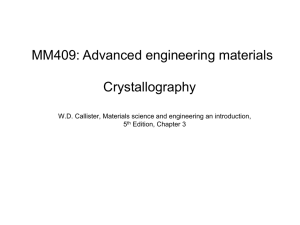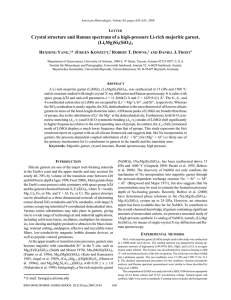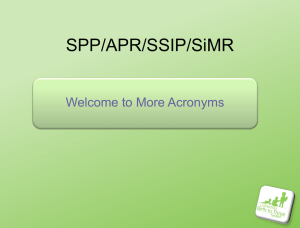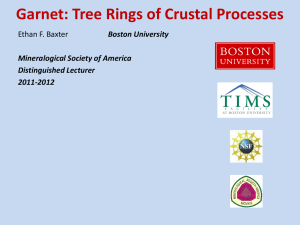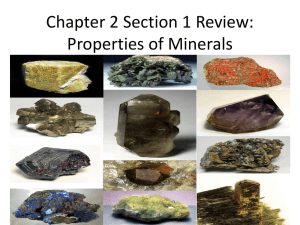EPSC501LectureWeek1_Jan2012
advertisement
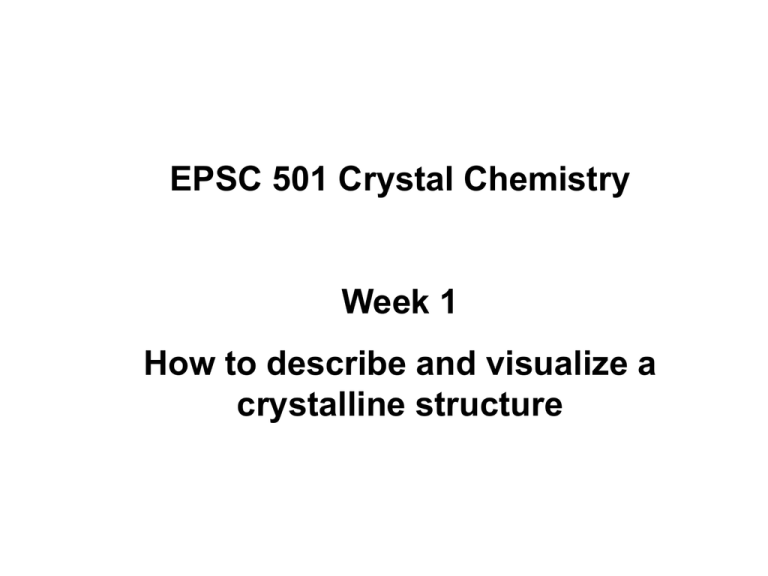
EPSC 501 Crystal Chemistry Week 1 How to describe and visualize a crystalline structure The vocabulary we need to describe the symmetry of crystalline structures… Let’s re-learn it by applying it to different examples. Operations that repeat a pattern in 3D space How to fill a unit cell Have you selected a structure that you will learn to describe? Did anyone try to search for a mineral (or a crystalline structure)? (Anyone…?) Hematite Fe2O3 hexaquairon III (dissolved) Below: as a trimer cluster (Recommended for minerals described in the geoscientific literature) Clicking on “Mineral” will let you search an alphabetical index. Handy if you aren’t sure about spelling… Why 15 determinations of the structure of hematite? How do these two descriptions differ? This is a plausible final exam question! We will ask it again when we meet next. What do you see in the header (first 5-6 lines) of each data files? Let’s focus on the first data file In each data file, the header indicates: • Author(s) of the published study • Where was it published (journal name, volume, year, pages) • Title of the paper • AMC database code The rest of the file describes the structure of the crystalline solid that was investigated… What is summarized in the box? (I reprinted the line below, in larger type…) 5.038 5.038 13.772 90 90 120 R-3c The unit cell is characterized by three directions along which a small subset of the pattern is repeated by translations. These translations are the “unit lengths” along the crystallographic axes a, b and c 5.038 5.038 13.772 90 90 120 R-3c Unit cell edges a, b and c There are six broad crystallographic systems, characterized by different degree of symmetry. In some of these systems, the angles between the three crystallographic axes are determined by some of the symmetry elements of the structure. These angles (alpha, beta, gamma) are listed after the unit lengths. angles , , 5.038 5.038 13.772 90 90 120 R-3c Unit cell edges a, b and c (in angstroms, 1 Å = 10-10 m) How wikipedia presents the structure… Where are these unit lengths and angles? 5.038 5.038 13.772 90 90 120 R-3c Axis “c” Let’s try to put it right side up! The c axis, conventionally, is vertical, the b axis is horizontal (usually in the plane of the page). The AMC datafile tells us a, b = 5.038Å; c = 13.772Å Color was used to distinguish Fe (blue) from O atoms (red). Is the information in the AMC data file consistent with this drawing? Let’s look at the positions of the atoms. Axis “a” Axis “b” The position of each atom is given as a fractional coordinate (a number in the range of 0 to less than 1) along the axes a, b and c. Can you find Fe at (0, 0, 0.3553)? Can you find an oxygen atom at (0.3059, 0, 1/4)? All the other atoms in this pattern are in positions that are predicted by the symmetry of the space group R-3c. What does the space group refer to? Who would bother memorizing the 230 space groups? Let’s use Table 11.9 from Dyar, Gunter and Tasa. With some practice, anyone can find quickly the space group… But you need to know what degree of symmetry is typical of each one of the six main crystallographic systems. The first letter of a space group refers to one of a few possible types of lattices. What is a lattice? “… a collection of imaginary points (“nodes”) that have identical environments in a homogeneous pattern…” The space group is the set of symmetry operations that relate these nodes. The symmetry operations are listed AFTER the type of unit cell (“R” in space group R-3c). The 14 Bravais lattices The “spheres” are called nodes. Each node represents an equivalent (or identical) point within a crystal structure. A node does not necessarily need to represent an ion or atom in a crystal structure. A node represents a motif that is repeated in the structure. The simplest lattices repeat a pattern at the eight corners of a boxlike volume, called the unit cell. Space groups with primitive cells are possible in each crystallographic system. Examples? P1 (triclinic) P2 (monoclinic) P222 (orthorhombic) P4 (tetragonal) P3 (hexagonal) P23 (isometric) Self-test #1: Can you assign each space group in this list to the correct crystal class (point group) and the correct crystallographic system? Are all the systems represented? (Answers are on the back…) Hexagonal system, primitive cell The space group of hematite is abbreviated as “R-3c”. First letters that are not “P” refer to a nonprimitive type of unit cell. In non-primitive cells, a motif is repeated within the cell (or on its “faces”), as well as at each corner of the cell. Hexagonal system, rhombohedral cell What are the types of cells? PRIMITIVE (P) Rhombohedral (R) BODY-centered (I) ALL-faces Centered (F) ONE-face centered (C) The “R” cell explains some of the repetition of the atomic pattern within the unit cell of hematite. But the full space group is R-3c… -3 is a rotoinversion axis “c” is a glide plane These symmetry elements also repeat the pattern throughout the lattice. http://img.chem.ucl.ac.uk/sgp/mainmenu.htm If you needed (or wanted) to know where these other symmetry elements are located and where they repeat the atomic pattern, you might consult this site… rotoinversion Screw axis But most of us won’t need to go there… What you must master about the 230 space groups and the 32 point groups for this course… 1) How to look up which one of the 6 crystallographic systems they belong to… A reference such as Table 11.9 will do. 2) What system of axes is used to describe the atomic positions? (This is specific to each system.) 3) Will the mirrors (or glide planes) and rotation axes be perpendicular or parallel to these axes? (This influences morphology during growth and some surface properties.) 4) What type of unit cell does this space group show? Let’s take a break… And if you downloaded a data file from the AMCD, let’s print it and make some photocopies that we might share within the group. By our next meeting January 17, you should: - Submit via WebCT data on the crystalline structure (or mineral) you propose to learn to visualize and describe - Check if the crystallographic data for its structure is in the AMC database (or another source) - read from the data its space group (and determine the corresponding crystallographic system and point group) - find from the data the fractional coordinates of its atoms - try showing atoms, bonds and polyhedra using XtalDraw Next week, we will - examine the geometry file produced by XtalDraw to examine the attributes of structural sites - examine the types of coordination polyhedra and how they are linked throughout diverse crystal structures Cooperite, PtS (this specimen from the Rustenburg District, South Africa) (Also reported from the Merensky Reef of the Bushveld Complex…) Why are Pt and the position (0, 0, 0.25) repeated within the description of the unit cell? Note the column after “x”, “y” and “z”, with the title “occ”. The values of that column refer to occupancy, i.e. the relative proportions of whatever occupies this site throughout the crystal structure. Are two elements occupying the same position in the unit cell? How is this possible? The meaning of values of occupancy… The proportions 0.988 (for S) and 0.012 (for Pt) indicate that, for every 1000 atoms detected at coordinates (0, 0, 0.25) – in other words, if a large enough number of unit cells were surveyed – you would find a sulfur atom at this position in 988 out of 1000 unit cells. Dispersed among them, 12 unit cells would show Pt at coordinates (0, 0, 0.25). But a JMOL-3D model (or XtalDraw) cannot represent different elements at the same site. The JMOL-3D model is (hum…) skimpy. (Were you able to fill the entire unit cell?) Is this atom at (0, 0.5, 0) or (0, 0, 0.25) ? This is the site with dual occupancy Occupancy is determined from the relative number and intensities of peaks observed within the diffraction pattern of excellent single crystals of a composition known with precision. Elements with different masses also have a different X-ray scattering power. Pt re-emits Xrays at a higher intensity than the lighter S atoms. If two elements randomly occupy the “same” site, the diffraction pattern differs from that of a structure where the elements are in sites unrelated by a symmetry operation. By comparing several data files published for cooperite… … we see how occupancy varies across specimens! Does that affect the unit cell? In 1932, these subtleties went unnoticed (possibly because the effect on the diffraction pattern was too subtle to detect and interpret without the computing power now available). Does any other part of the description suggest that the lack of computer power limited the precision of a crystal structure refinement? The JMOL 3D model accessible at the AMCD site is too skimpy for our purpose… We want to fill the entire unit cell! Let’s try with XtalDraw… First, download an AMC file on a computer drive or memory stick you can access. (Save it under a memorable name, but do not change the filename extension: “cooperite.amc”, for example…) Let’s start XtalDraw and open the file… The atoms are assigned different radii (much larger for S, than for Pt). The unit cell can now be completely filled. Can we see the same atomic pattern repeated at the eight corners? (We should since the unit cell of P4 2 /m m c is primitive…) Can you show that each Pt is surrounded by four sulfur, in a square planar arrangement? This is unusual. Anions in most crystalline solids surround the cations in a coordination typically described as 3D polyhedra. Don’t be surprised to see the same structure described differently in peer-reviewed journals. In space group P4 2 /m m c, the axes a and b can be chosen at 45 degrees from those in the description archived in the AMCD. The squareplanar groups are diagonal through the cell. Garnet group An example where crystalline solids share: a single structural formula the same atomic pattern: Similar coordination polyhedra but their elements differ the same symmetry (described by the same space group)? These end-members are listed, and many are discussed in Locock (2008) A useful reference (in general): Nickel and Grice, 1998. The IMA commission on new minerals and mineral names: procedures and guidelines on mineral nomenclature, 1998. Canadian Mineralogist, vol. 36, pp. 913-926. (IMA: International Mineralogical Association) A reference for the chemistry of the garnet group: Locock, A.J. (2008). An Excel spreadsheet to recast analyses of garnet into end-member components, and a synopsis of the crystal chemistry of natural silicate garnets. Computer & Geosciences, vol. 34, pp. 1769-1780. Garnet group What is the definition of an “end member”? End members have idealized site occupancies, and are useful to describe compositional variation. The names in italics are hypothetical mineral species, i.e. they have never been found in nature, but might have been synthesized in laboratory. They are also referred to as “end members”. Naming minerals: mineralogical nomenclature in solidsolution series follows a system called “the 50% rule” (in binary solid solution series, defined by two end-member mineral species). In a ternary solid solution (i.e. 3 end-member species), it is more correct to call this the 100%/n rule or the dominantconstituent rule, in which the constituents are atoms (cations or anions), molecular groups, or vacancies. CN= 6 CN= 4 CN=8 All species of garnet share the same structural formula, based on three distinct coordination polyhedra that share specific edges or corners. Dana’s chemical classification (51) Nesosilicate Insular SiO4 Groups Only A chemical (51.04) with cations in [6] and >[6] coordination classification (51.04.03b)Garnet group (Ugrandite series) of minerals 51.04.03b.01 Andradite Ca Fe (SiO4) I a3d 4/m -3 2/m that takes 51.04.03b.02 Grossular Ca Al (SiO4) I a3d 4/m -3 2/m 51.04.03b.03 Uvarovite Ca Cr (SiO4) I a3d 4/m -3 2/m into account 51.04.03b.04 Goldmanite Ca (V,Al,Fe) (SiO4)3 I a3d 4/m 3 2/m the 51.04.03b.05 Yamatoite? (Mn,Ca) (V,Al)2(SiO4)3 I a3d 4/m 3 2/m coordination (51.04.03a)Garnet group (Pyralspite series) environment 51.04.03a.01 Pyrope Mg3Al2(SiO4)3 I a3d 4/m -3 2/m of ions. 51.04.03a.02 Almandine Fe3Al2(SiO4)3 I a3d 4/m -3 2/m The Garnet group 51.04.03a.03 Spessartine Mn3Al2(SiO4)3 I a3d 4/m -3 2/m 51.04.03a.04 Knorringite Mg3Cr2(SiO4)3 I a3d 4/m -3 2/m covers a broader 51.04.03a.05 composition than the Majorite Mg3(Fe,Al,Si)2(SiO4)3 I a3d 4/m -3 2/m 51.04.03a.06 Calderite (Mn,Ca)3(Fe,Al)2(SiO4)3 I a3d 4/m -3 2/m ugrandite series. 3 2 3 3 2 3 3 2 3 3 2 3 Is the garnet structure found only in silicate minerals? Consider schaferite: Ca2NaMg2V3O12 What element(s) fill the A site in natural garnet? ...in Schaferite? What element(s) fill the B site? What element fills the Z site (tetrahedral)? Why is it said to have the “garnet structure”? Mineral names are sometimes used to refer to (and “personalize”) certain types of crystalline structures. In the chemical classification of minerals, “garnet” are silicates from the subclass “51” of orthosilicates (or nesosilicates) with the general formula A2+3 B3+2 (XO4)3 . Schaferite is from a different chemical class (Dana class 38): which includes phosphates, vanadates and arsenates with the general formula (A+ B2+)5 (XO4)3 “Garnet structure” refers to the similar proportions of and edge-sharing among the 8-, 6- and 4-fold coordination polyhedra. For this reason, schaferite is said to be isostructural with the garnet group. Eventually, for your 2nd assignment, you will look for an example of a property that varies with composition. The structure of the two crystalline solids you should compare must be identical (you will be expected to provide the reference.) The property must have been observed in two crystalline solids that share the same degree of symmetry (described by a space group) but differ somewhat in composition. One or several of the sites in the structure will be occupied by a different element. From the American Mineralogist crystal structure database Which elements in this description of uvarovite are filling the same site throughout the crystal? Look for lines with he same x,y, z fractional coordinates…. The files for your own mineral might show examples of compositional variation within that mineral species. Next time: which site (8-fold, 6-fold or 4-fold) of the garnet formula viiiA3viB2ivZ4O12 are Ca and Mn filling? How can we use XtalDraw to show me this? How can you tell that this fragment of the garnet structure is from an incomplete unit cell? From which system is the garnet structure? We would expect to see the same type of ion at the eight corners of a cube-shaped unit cell. Full space group: I41/a bar-3 2/d This is usually abbreviated to: Ia3d Enough information was left to identify this space group as isometric (cubic). What gives it away? Table 11.9 gives you point groups and their corresponding space groups. Keep it handy… we will use it throughout the course. 32 point groups (= 32 crystal classes) This list displays abbreviated notations for the Herman-Mauguin symbols = 2/m 2/m 2/m From “Web Mineral” at http://webmineral.com/data/Pyrope.shtml Pyrope a = 11.459, Z = 8; V = 1,504.67 Den(Calc)= 3.56 H-M Symbol (4/m bar-3 2/m) Space Group: I a3d (Z = no of formula units per unit cell. An I-cell has a minimum Z of 2, but in garnets, this is multiplied by the presence of glide planes and/or screw axes that repeat the pattern elsewhere within the cell.) You might find the same information in other sources… or not. Different texts, different database serve different purposes. - Nesse “Introduction to Mineralogy”? - Klein & Hurlbut “Mineral Sciences”? Not all this information is included in files from the American Mineralogist Crystal Structure Database. Did anyone choose a pyroxene? Whoever picked diopside should be able to interpret this description… and relate it to the formula of diopside. 1) What fills the M2, M1 sites? 2) Here, no column for “occ” after the x, y, z coordinates. Why not? Spinels Another example of a group important in mineral and material sciences… Like the garnet group, the spinels are described by a general formula.




